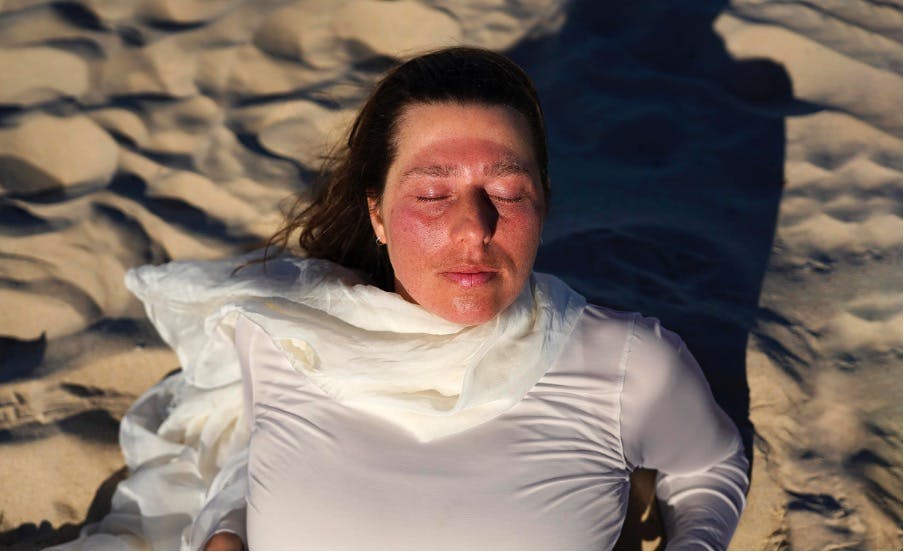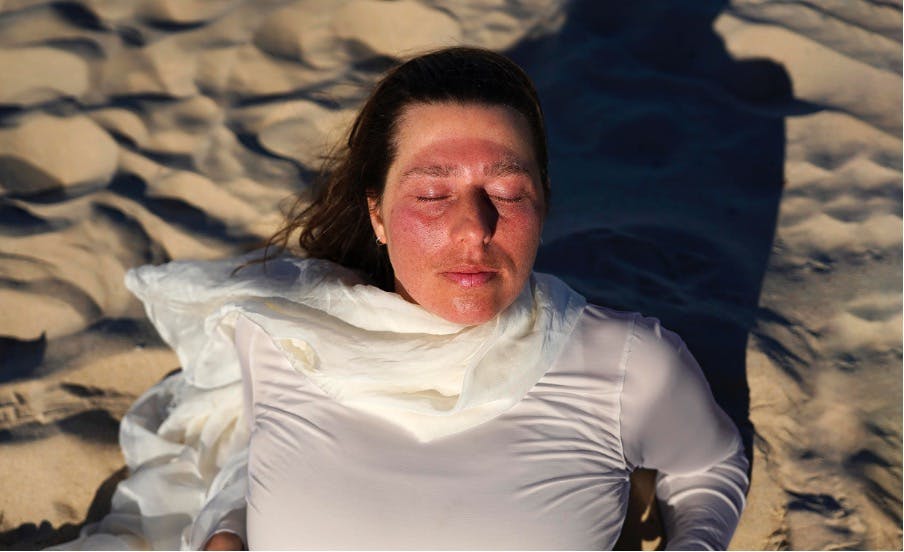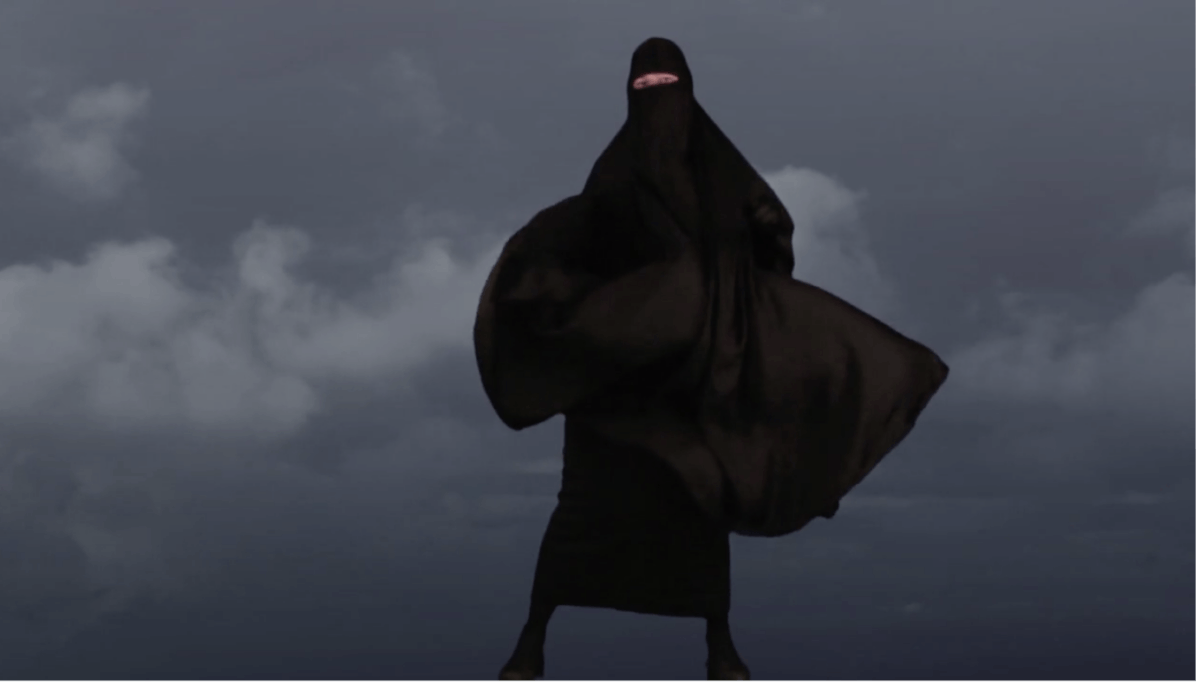It wasn’t like life was hard but I guess the nature of racism is that it is just so prevalent and it is evident in little conversations. I would get asked why do Muslims chop hands off and as a little kid navigating those kinds of questions is a form of racism. You don’t realise until you get much older. So I think part of my art practice has bene unpacking those questions and going well that was kind of weird when someone did that or questioned me about this.

Unveiling through art
Kobra Sayyadi in conversation with Cigdem Aydemir
Cigdem Aydemir is a Sydney-based contemporary artist whose work primarily engages with the topic of veiling and the way in which Muslim women are commonly depicted and perceived in Australian society.

Cigdem Aydemir. Photo Credits: Kobra Sayyadi
Cigdem Aydemir is a Sydney-based contemporary artist whose work primarily engages with the topic of veiling and the way in which Muslim women are commonly depicted and perceived in Australian society. Cigdem draws on her Turkish-Australian heritage and past experiences as a veiled Muslim in Sydney to inform her art practice. Her various installation, performance and video art pieces often explore the social and political nuances surrounding the topic of veiling.
Her two submitted artworks for the 2022 Bankstown Arts Biennale included ‘Stasis (a map of home)’ and ‘Bombshell, 2013’. Earlier this year I had the opportunity to interview Cigdem about her artworks. The central question that became apparent to me through our conversation was that of identity and the path to individuation. Is a person’s identity fixed or fluid and how do they come to redefine themselves as they progress in life? In exploring this, we also discuss the crucial role art and artistic expression can play in aiding this process of self-actualisation and helping us reclaim the parts of us that make us who we are.
Art can help us process and integrate our life experiences and in doing so we can become more well-rounded and authentic individuals. At the start of our conversation, Cigdem quotes Australian-British writer Sara Ahmed in defining the role of artists and writers as ‘space-makers’. She adds that ‘the moment we express ourself and explore our identity is when we are creating space for others to do the same as well.’ The topic of veiling is directly relevant to at least 3.2 per cent of the Australian population who identify as Muslims. In engaging with artworks such as Cigdem’s we can contribute to the ongoing dialogue around the topic of veiling and in doing so foster a better informed and more discerning society. In creating art, we are not only expressing ourselves as individuals but influencing other people who may relate to our experiences.
As a young Turkish-Australian growing up in Sydney, Cigdem experienced overt racism directed at her for being a veiling Muslim. Having come from a religious family in which veiling was the norm for most women she started wearing the hijab around the age of 9 or 10. She attended an Islamic school in Year 7 and 8 where veiling felt like ‘the most comfortable thing ever’ but the following year moved to a public school in which she was the only other veiled girl in the entire student cohort. Soon after, Cidgem became the target of bullying and racist remarks about her religion.
Having experienced this type of racism in her formative years, Cidgem felt she had to fight for her right to veil and ‘by necessity [it became] something that I held even closer’. Through her art practice, Cigdem has been able to metabolise and make sense of these experiences and in doing so invites the audience to also take part in reflecting on their own experiences and worldviews. Cigdem put it best when she said ‘art can be a powerful way of unpacking those experiences and seeing them in a new light.’ Moreover, this process of retrospection is a key factor of the individuation journey in order to fully realise ourselves and become unique individuals.

Stasis (a map of a house), 2019. Image courtesy of the artist.
In explaining the significance of the title ‘Stasis (a map of home)’, Cigdem draws on the idea of a ‘nomadic identity’ from the work of philosopher Rosi Braidotti. Braidotti proposes that identity is retrospective therefore representing it requires us to constantly draw and re-draw “accurate maps” of the metaphorical places we have been in our lives and may no longer be.
For me, [Stasis] is a moment of rest, a moment of pause, where the different parts of yourself can co-exist in one place.
Cigdem decided to take off the veil at the age of 20. She explains that despite this decision she still carries many fond memories of the decade or so of her life in which she wore the veil on a regular basis and that it will always mark an important part of her journey.
Referring to the tan line bordering her face in Stasis, Cidgem recalls feeling frustrated as a teenager at the unnatural tan that would form around her face after a day in the sun whereas thinking back on it feels nostalgic as though wearing something from the past that has a special connection to her.
I thought it an interesting tattoo, like a little memory of something that is important to me, like a marker on my skin. I thought that could be a kind of map of where I have been and where I am now.
Stasis may be seen as a tribute to that part of herself and her experiences as a veiled Muslim women.

Bombshell, 2013. Image courtesy of the artist.
Bombshell is a video installation that parodies the white dress scene from the 1955 film, Seven Year Itch, in which Marilyn Monroe laughs as her dress is blown up from a blast from a subway vent. A play on words, the bombshell in this artwork appears at first glance to be an inverse of the Marilyn Monroe scene. The white dress is replaced with the black veil. The bombshell doesn’t appear to be the conventional attractive blonde and the sexual tension of the scene takes a more ominous tone in Cigdem’s parody. Yet, there is still a playful energy in the artwork as the subject moves hypnotically in rhythm with the flow of the fabric. I ask Cigdem what inspired this particular artwork.
I am a very visual person and I have got a strong imagination. I just had this image of the veil in the shape of a Marilyn Monroe dress. I find fabrics so beautiful, it is really beautiful when it moves through air and wind and there is something almost spiritual about it. So then I thought bombshell, that is really interesting because people are accusing Muslim women of hiding bombs so shell for a bomb [versus] the sexy women definition of bombshell.
The veil, as a religiously charged symbol with political and social connotations brings up many conscious and socially engrained ideas in the viewer’s mind. Bombshell helps to invert some of these expectations by challenging the audience to think about what they are seeing in a new context. I asked Cigdem what role parody played in her artworks.
They might say we are in a multicultural society, we never think we are racist or anything like that but as soon as you make a work like that there is all this uncomfortable laughter, it is unsettling and it is very funny. It is also very empowering for us Muslims, well for me at least, to be able to laugh at that kind of thing because for so many years it was oppressive to live with that kind of racism.
For Cigdem Ayedmir, art became the medium for her creative expression and voice. It enables her to empower other Muslims to stand up for themselves, represent themselves and speak back to power.